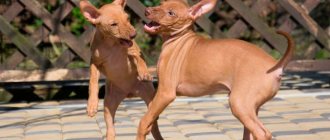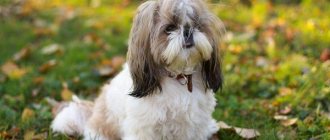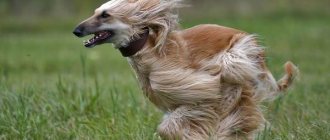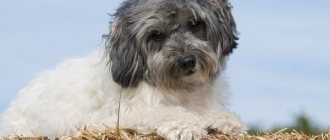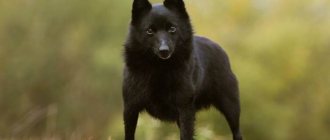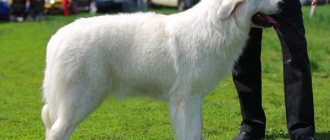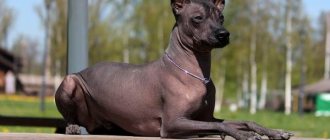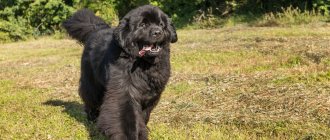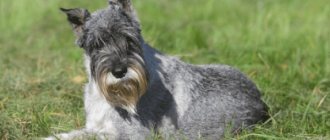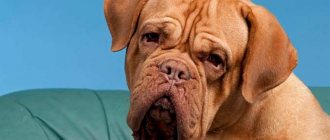Some dog breeds are striking in their appearance. Among them, dogs with a split nose occupy a special place. Only three breeds of dogs have this peculiar feature: the Old Spanish Pointer, the double-nosed Tiger Hound and the Catalburun. Representatives of the latter breed are considered quite rare animals.
Some German Shorthairs and Portuguese Pointers may have a forked nose, but this is most likely a manifestation of the close relationship with the Old Spanish Pointer.
Description and features
If you look at the catalburun in profile, you won’t see anything unusual. An ordinary fine dog, slender, strong, clearly related to hounds, or more precisely, to pointers. That's what they call her - the Turkish Pointer. But if you look at the front of this dog’s face, you will be very surprised.
Here a surprise awaits you - a bifurcated nose, sometimes so much so that the two halves of this organ do not touch each other. It looks very unusual and even strange. The dog was named catalburun (chatalburun) precisely because of its nose. Translated from Turkish, “burun” is a nose, and “katal” (“chatal”) is a fork. In other words, this is a fork-nosed dog. To be more precise, a Turkish fork-nosed pointer.
The Catalburun dog has an excellent sense of smell, even with such a nose! For hunters, rescuers and police, such a dog is just a treasure. But the main problem is that this breed is still not recognized by the International Canine Association. Therefore, its cultivation and promotion is an activity for the elite.
But it would seem, why does she need certificates? Her document is an aristocratic appearance. In terms of build and appearance, it most closely resembles an English pointer. Catalburuns have the same short, hard hair, drooping ears, slender, strong body, endurance, and speed. Weight is approximately from 15 to 30 kg. The height of females and males varies slightly, on average reaching 45-63 cm at the withers.
The calling card of this breed is the famous sculpted stance. The forknos in a special position freezes at the sight of game, pointing to it to the owner. You look at a dog frozen in a hunting pose, and it seems that in front of you is a postcard from an old album called “ Katalburun in the photo during the hunt.”
6) Tibetan Mastiff
This breed is a direct descendant of the mastiffs of ancient times. This huge, woolly dog is a fierce guard in its homeland in the Himalayas. When the dog was first brought from the highlands to the plains for sale and breeding, it developed many diseases. Fortunately, today the breed has already explored new territories and has been crossed with other dogs for a gentler disposition. Males of this breed can reach 80 kilograms!
Kinds
The Catalburun breed does not have a standard, so these dogs can come in different colors and even vary in size. The only thing I can add is that freckled dogs with the main coat color of a light gray or white shade are most often popular.
Hemp or small spots can be of completely different colors - red, yellow, red, brown, dark gray, brown, black. We referred to the similarity with pointers, so a few words about this wonderful breed, since they can be mistaken for distant relatives of our dog.
The English Pointer is an old British breed of pointing dog; the first mention of them dates back to the mid-17th century. These dogs were bred specifically for hunting and were used mainly for this purpose. The characteristic appearance of a smooth-haired slender dog, hanging ears, grace and elegance, as well as a noble pedigree are the main characteristics of this glorious breed.
And also, of course, the famous hunting stance with one paw raised, head lowered and fur raised. This is how they “mark” the found game for the owner. A dog entering the royal court. Perhaps many people do not have such a famous pedigree.
The standard color is one- and two-color. Single-color specimens come in red, coffee, black and all shades of fawn. Two-colored - black-piebald, coffee-piebald, yellow-piebald, red-piebald. The character, external parameters, behavior and working qualities are very close to our fork-nosed dog.
Well, a few words about another dog, the Old Spanish Pointer, whose appearance is especially close to our hero. This is a very rare breed of dog, so few people know about it. The most distinctive feature, in addition to all the qualities inherent in pointers, is the same forked nose as that of the Turkish catalburun.
History of the breed
The homeland of this dog is considered to be the city of Tarsus (in ancient times Tarsus), which is located in the Turkish province of Mersin. This city is known as the birthplace of the Apostle Paul. The exact time of the appearance of fork-noses is difficult to establish, but it is definitely known that they were already present in the mid-17th century, and even at that time it was not the first day.
How this miracle appeared is now difficult to say. Perhaps this phenomenon arose due to close family ties. A consequence of inbreeding, a form of homogamy, the crossing of dogs within the same genus. Or maybe this dog got this charm by chance from other famous fork-nosed dogs.
After all, there have already been such phenomena in history; we mentioned the ancient breed of Old Spanish Pointers, otherwise known as Navarrese pointers. An almost extinct breed, but thanks to enthusiastic cynologists, it was restored and exists to this day, although it is very small in number.
Unfortunately, catalburuns are also very rare. In the heart of their breeding, in Tarsis, about 300 specimens can now be counted. There are also several such dogs in Russia and other countries, but you can literally count them on your fingers.
10) Chinook
Dogs of this breed are direct descendants of one of the famous sled dogs named Chinook. After the death of its breeder in 1963, the number of dogs of this breed declined sharply, and it was even believed that it might disappear completely. However, dog lovers discovered 11 representatives of this breed in 1981 and began working to restore the breed's numbers. Today the Chinook is a domestic dog, but its ability to move heavy loads is exploited by some owners.
Character
The character of the Catalburun dog is also similar to the Pointer. Dogs are smart, quick-witted, moderately cunning, adore their owners, and love children very much. In the circle of their family, they are playful, loving, gentle, caring, sometimes slightly annoying and fussy, but this is due to an excess of emotions.
Most often, the dog is calm, balanced, self-sufficient, and it is not difficult to call him to order. He responds to respectful treatment; he should be treated only on the basis of mutual understanding, delicately, without shouting or rudeness. Still an aristocrat...
But with strangers he can be unfriendly and stern. In addition to the profession of a hunter, he gets along well as a security guard and a watchman. No one will enter your home without his knowledge and consent. The same applies to other people's animals.
If a stranger invades his territory, he will be immediately attacked. Moreover, the transformation from a “darling dog”, so calm and affectionate, into a barking “evil Cerberus” is carried out with lightning speed. He is driven by blind rage, and the dog enters such an angry state that he may not even hear your stopping commands.
The Turkish Forknoss is very trainable, matures earlier than other breeds, and is very inquisitive. Therefore, it will not be difficult to train him. This pet will be an excellent walking companion, comrade, assistant and family member.
Nutrition
The dog eats with great enthusiasm and is unpretentious in his diet. Just try not to accustom him to harmful goodies from the table. No sweets, pastries, smoked meats, canned food - all this is harmful to him. His food is lean meat and fish, vegetables, cereals, dairy products, eggs, vegetable oil. If you decide to feed him natural food, add vitamins and minerals. Don't forget to occasionally pamper your pet with a bone!
It is easier to purchase ready-made balanced food for active dogs. Preferably “premium class” or “holistic” (natural based). Sometimes, no more than once a week, you can give pasta and potatoes. And always keep an eye on the water in the cup. An energetic dog needs fresh and clean water.
5) Carolina dog
This dog is often called the "American Dingo" and is genetically related to primitive dog breeds such as the Australian Dingo and the New Guinea Singing Dog. This breed is surprisingly adaptable. Unlike various domestic dogs that come into heat twice a year, the Carolingian dog only comes into heat once a year like other wild dogs.
Reproduction and lifespan
The price of the Catalburun breed can be so high in some places that you can’t help but think – maybe you should start breeding them yourself? But we must not forget that with any rare breed there may be nuances and difficulties during breeding. Moreover, you are unlikely to be able to officially place the puppies later. However, here are some tips for breeding these dogs.
- It is better to breed a girl after 2-3 heats, nothing good will happen before.
- Boys are ready for mating at the age of 6-8 months.
- It is advisable to hold the wedding on the territory of the groom or in another convenient place, but under no circumstances on the territory of the bride.
- Before the process, you can walk the dogs, but you should not feed them.
- The second, control mating is carried out no earlier than one day after the first.
- When choosing a puppy from the same litter, follow the old method - take a closer look at which one is the most active and inquisitive, the first to run up to food, and he will be your friend. In addition, examine the puppy for the obligatory “dog charms” - a moist nose, clear and attentive eyes, warm ears with delicate fur, not very thin, a clean mouth, straight legs and a beautiful color. Preferably not too much white.
If you carefully look after your beloved dog, feed it properly, and take it to the vet on time, it will live to at least 14-15 years.
How to choose a puppy
It is recommended to adopt puppies of the Armenian Gampr breed no earlier than two months of age. While still a puppy, your chosen one should be inquisitive and brave. Observe his behavior and take the most active one. In order to check the baby's health, touch his stomach; it should not be swollen or hard, and there should be no irritation on the skin.
Inspect the ears, they should be clean and free of unpleasant odor. From improper maintenance, puppies can develop rickets; this is expressed as peas on the ribs, which can be felt if you touch them with your fingers. Only on the bends of the paws are there slightly protruding cartilaginous points.
Description of the Armenian Gampr breed:
- Head. Large, without prominent angles, not thin. The skull is wide, smooth transition from the forehead to the muzzle. Smooth forehead, powerful jaws. The ears are located just below the eye line. The eyes are small, almond-shaped, slanted, deep-set, somewhat darker than the color of the coat.
- The teeth are white and closely spaced. Scissor bite. The neck is muscular and of medium length.
- Frame. Elongated shape, not due to the lower back, but due to the chest. The chest is deep and wide, falling below the elbow joint. The belly is slightly tucked up and is a continuation of the chest line. The back is straight, wide, muscular and strong. The loin is short. The croup is straight, elongated and wide.
- Tail. Set on high, lowered when calm. When moving or in an irritated state, it takes on a crescent shape over the back.
- Forelegs. Straight, parallel to each other. The wrists are massive and long, when viewed from the side they are set obliquely, but when viewed from the front they are parallel.
- Hind limbs. Straight and parallel to each other, with well-defined knee joints.
- Paws. Sturdy, strong with soft pads.
- Wool. On the forelimbs, ears and muzzle - short, in other areas either with elongated guard hair or with thick short hair.
- Color. Any color is allowed, with a darker mask on the face. Brown and liver colors are undesirable.
Care and maintenance
Catalburun care is minimal. A couple of times a week, stroke it with a special glove or a damp towel to collect lost hairs. And if you run your hand over his sensitive skin, he will be simply happy!
During molting, you can do this more often. Brush your teeth, ears and eyes periodically, about once every 7-10 days. And sometimes trim the nails if the dog has not ground them on hard surfaces. As it gets dirty, you can bathe your dog, especially if it lives in an apartment with you. Just dry it immediately with a towel.
His health is good. True, there are specific problems - lop-eared dogs are susceptible to otitis media. And his famous forked nose can also sometimes become inflamed from a cold. Try not to overcool your dog, especially since his coat is quite short and he is genetically predisposed to heat. In Turkey they just live on the streets.
And our climate is harsh, in winter the dog will need to be insulated for a walk. And under no circumstances leave it outside for a long time in winter. You need to walk them for a long time; these dogs need good physical activity, without which they quickly get fat and start to get sick. Don't forget to get your vaccinations on time. When going to the vet, check the condition of the skin for dermatitis, joints and the thyroid gland.
Catalburun health
Unfortunately, the modern canine world is not yet sufficiently aware of the problems that exist with the health of “fork-noses”. The small number of species and only relatively recently begun laboratory studies do not yet allow us to talk about real statistics of predispositions. Therefore, for now we can only talk about some known facts.
It is known that the average life expectancy of Turkish Pointers is about 10–13 years. At the same time, being an aboriginal breed that has undergone serious natural selection over centuries of existence, Catalburun dogs are distinguished by good health and high resistance to diseases. You are especially convinced of this when you get acquainted with the unsatisfactory conditions of keeping pointers by some Turkish “breeders”.
Today, it is believed that Turkish Pointers are susceptible to three diseases typical of all Pointers: hip and elbow dysplasia; various dermatitis; hormonal disorders (especially thyroid dysfunction).
Work to clarify breed problems is now actively underway in Turkey; perhaps soon we will know much more about the health of these undoubtedly unique animals.
Price
The breed is very rare, if you do not plan to go bird hunting with this dog, you probably should not get this dog. He's not a lapdog at all. Moreover, to purchase it you literally have to go to Turkey.
It costs less there, and the breeders are more reliable. The average price of a puppy ranges from $700 to $1,200. And outside the historical homeland, the price can be absolutely anything. There is demand, but supply is limited.
Interesting Facts
- By the way, the same Navarrese pointers, which are considered the ancestors of the Catalburuns, gave rise to another breed - the double-nosed Andean hound from Bolivia, a dog so rare that it is difficult to even see it.
- These dogs are not only the best bird hunters, especially partridges. They are excellent customs officers. Their unique sense of smell is used during customs control to detect weapons and drugs.
- Catalburuns are one of those breeds that are susceptible to a split palate, the so-called “cleft palate.” This is a congenital defect condition; a dog with such “split” palatal tissue may be considered a defect.
- Some dog experts believe that the Navarre hounds were not the ancestors of the Catalburuns, but, on the contrary, they themselves descended from them. But Turkish fork-nosed cops are much older, and they appeared in ancient Greece.
